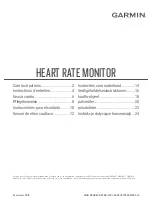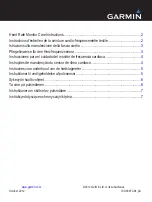
7
Kaleido-X
Release Notes
logical sources that had a category defined in the
Cat.
column, under
Source info
, in
the sources table.
•
[Ref. #36661]
Kaleido-IP:
Kaleido-IP systems with audio monitoring enabled may
momentarily stop working after a number of days. The frequency and likelihood of this
happening is dependent on the number of streams begin monitored and on the
network load.
•
[Ref. #36163]
Kaleido-X (14RU) with large router:
After restarting an Kaleido-X (14RU)
expansion system configured with a large upstream router (for example a
configuration with more than 1000 inputs), if the current layout uses most of the tie-
lines, then some monitors may show an error message (
Unable to control the upstream
router
) instead of the expected router sources.
•
[Ref. #35514]
Kaleido-X16, Kaleido-X (4RU), Kaleido-X (7RU):
After importing a large
router configuration (for example a configuration with more than 1000 inputs), the
multi-viewer may momentarily exhibit reduced responsiveness due to high CPU usage.
•
[Ref. #33815]
Aliases from NVISION router configurations:
Alias changes initiated from
NV9000-SE Utilities may fail to be reflected on the monitor wall.
Bugs Fixed in Kaleido-X Version 6.40
•
[Ref. #28330]
Video corruption in full screen zone:
When a full screen layout is loaded in
front of a particularly complex area on the monitor wall (e.g., against a layout with
several video windows, audio level meters, graphically demanding alarm settings),
video in the full screen zone may appear corrupted.
•
[Ref. #34779]
Kaleido-X, Kaleido-X16 freeze detection:
On occasions, slow, dark scenes
may result in false video freeze alarms being generated.
•
[Ref. #35563]
Kaleido-X, Kaleido-X16 metadata extraction:
After setting a video
monitor’s text mode to CC (608) from the monitor wall menu, the closed captions and
V-chip ratings may fail to be displayed, and related false alarms may be reported.
•
[Ref. #34742]
KMV-3901/3911 mouse pointer:
On a monitor wall display connected to a
KMV-3901/3911 and configured with a resolution of 1920 × 1200, the mouse pointer
may not completely disappear after 15 seconds of inactivity (the tip of the pointer may
remain visible).
•
[Ref. #35189]
KMV-3901/3911 and virtual alarms:
Virtual alarms created in XEdit for a
KMV-3901/3911 multi-viewer have an incorrect path by default, which prevents them
from reporting their status on the monitor wall.
•
[Ref. #34720]
Virtual alarms:
In XEdit versions 6.00 – 6.32, it is not possible to base a
virtual alarm on a router destination crosspoint status.
•
[Ref. #34516]
Alarm scheduling:
Settings related with alarm scheduling and alarm
inversion (snooze duration, grace period duration, etc.) set in iControl from the GSM
Note:
Although the NV9000 router control system supports 16 name sets,
router configurations you import from the NV9000 system into your multi-
viewer configuration are limited to 1 name set for a KMV-3901/3911 multi-
viewer, or 5 name sets for the other multi-viewer models. (In the context of
the NV9000 router control system, a name set is the equivalent of a set of
source aliases in XEdit’s representation of a physical router.)












































